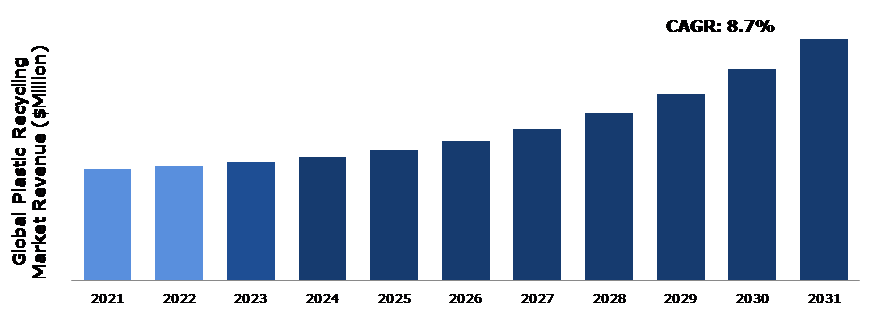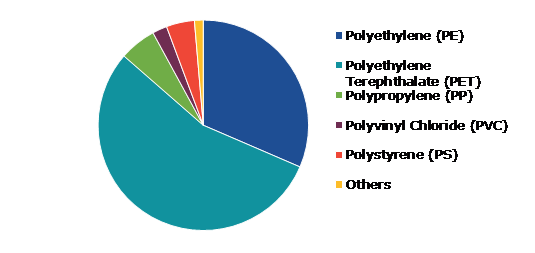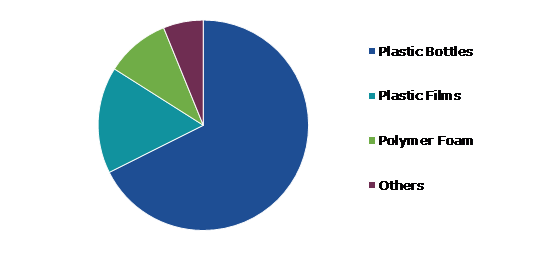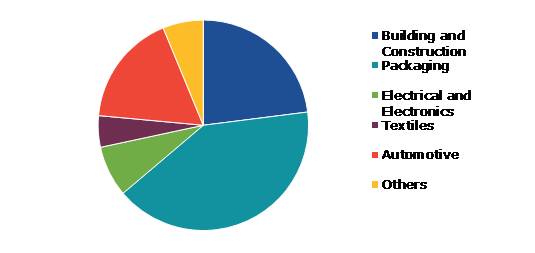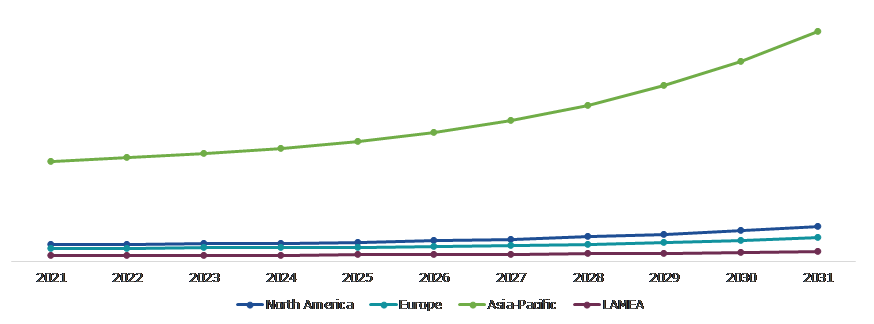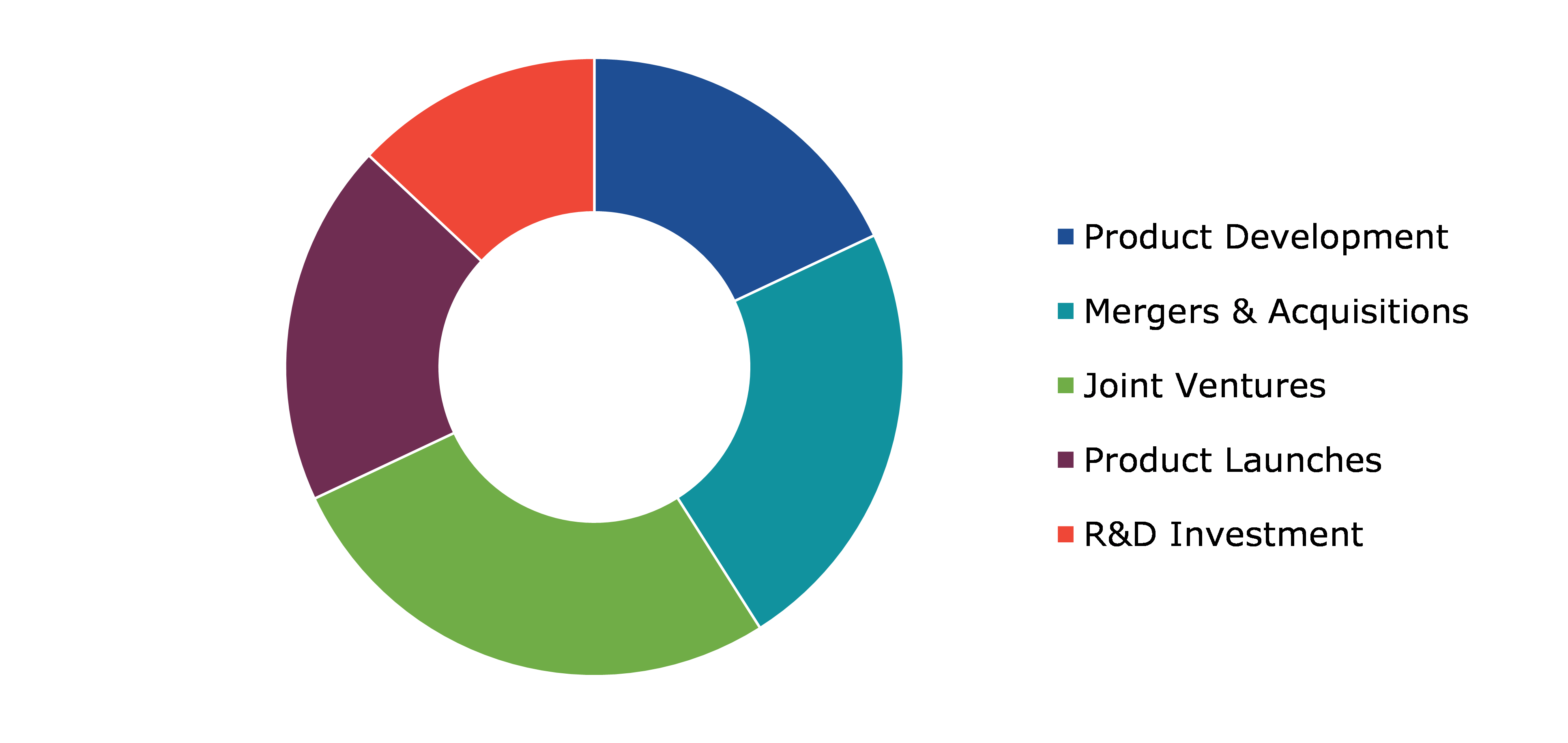Plastic Recycling Market Report
RA00173
Plastic Recycling Market by Product (Polyethylene (PE), Polyethylene Terephthalate (PET), Polypropylene (PP), Polyvinyl Chloride (PVC), Polystyrene (PS), and Others), Source (Plastic Bottles, Plastic Films, Polymer Foam, and Others), Application (Building & Construction, Packaging, Electrical & Electronics, Textiles, Automotive, and Others), and Regional Analysis (North America, Europe, Asia-Pacific, and LAMEA): Global Opportunity Analysis and Industry Forecast, 2022-2031
Update Available On-Demand
Global Plastic Recycling Market Analysis
The Global Plastic Recycling Market Size was $27,900.0 million in 2021 and is predicted to grow with a CAGR of 8.7%, by generating a revenue of $60,962.8 million by 2031.
Global Plastic Recycling Market Synopsis
The plastic recycling market has experienced substantial growth in recent years on account of various factors. Growing awareness of the negative environmental effects of plastic waste and the need to cut carbon emissions are some of the major factors driving the growth of plastic recycling market. Investment in recycling infrastructure has been promoted by government policies and programs that attempt to cut down on plastic waste and advance sustainability. Today, a wider variety of plastics can be recycled as a result of cutting-edge recycling technologies including chemical recycling and pyrolysis, which has had a positive impact on the market. In general, a growing understanding of the value of circular economy concepts and the need to make the transition to a more sustainable future are driving the plastic recycling business.
However, there are still a number of obstacles to further develop the plastic recycling market. Lack of infrastructure and funding for recycling facilities, especially in developing nations, is one of the major problems. Due to this, there is a significant imbalance between the production of plastic garbage and recycling capacity, with a sizable part of plastic waste still ending up in landfills or the environment.
Entrepreneurs and investors have a number of opportunities in the plastic recycling business. There is an increasing need for solutions to this issue as people throughout the world become more conscious of the negative effects plastic waste has on the environment. Recycling plastic is a crucial step in reducing plastic waste and keeping it out of the landfill and the ocean. Setting up a recycling plant, developing cutting-edge recycling technology, or purchasing stakes in already-existing recycling businesses are few examples of how to invest in the plastic recycling sector. Entrepreneurs might also look at possibilities for creating new products from recycled plastic or offering services related to recycling.
According to regional analysis, the Asia-Pacific plastic recycling market accounted for the highest market share in 2021. The region is the largest producer and consumer of plastic across the world. Government policies and rising consumer demand for eco-friendly products are some of the major factors attributed to the growth of the plastic recycling market in this region.
Plastic Recycling Market Overview
Recycling plastic involves turning used plastic waste into useful materials or goods. The objective of plastic recycling is to lower the amount of plastic waste that ends up in oceans, landfills, and other natural environments, and to preserve natural resources by developing new products from recycled materials. Recycling plastic is a critical step toward creating a more sustainable future. Although there are difficulties involved in recycling plastic, the advantages of lowering plastic waste and protecting natural resources make it a crucial component of the solution to the plastic waste issue.
COVID-19 Impact on Global Plastic Recycling Overview Market
The market for plastic recycling has been significantly impacted by the COVID-19 outbreak. The outbreak disrupted the overall economic situation, disrupted the supply chain, and decreased demand for recycled plastic. The pandemic caused supply chain disruptions, including a labor shortage, closed recycling facilities, and delays in transportation. Due to this, there was less plastic garbage that could be collected and processed throughout the pandemic. Crashing oil prices caused an excess of cheap virgin plastic to flood the market and reduce the competitiveness of recycled material. The majority of plastics currently in use throughout the world are virgin and synthetic, which means they were first converted into polymer resin, which was then used to create the final plastic product. It is a long supply chain that crosses industries and continents. As a result, every link in that network was impacted when the price of oil significantly dropped. Moreover, the global recession made manufacturers and consumers more price sensitive and less likely to recycle plastic.
However, the plastic recycling market rebounded post COVID-19 pandemic and is expected to keep expanding due to increasing emphasis by governments on sustainability and lowering plastic waste. This might enhance consumer demand for recycled plastic and open up new business and investment opportunities in the sector.
Growing Government Policies Worldwide towards Reducing Plastic Waste to Drive the Market Growth
Incentives and regulations from governments all over the world are propelling the plastic recycling industry's growth. Government policies have a significant impact on the way the market for recycled plastic expands. Numerous governments all around the world have put rules into place to encourage sustainable practices and promote the growth of the recycling industry. The use of single-use plastic products has been outlawed in several nations, and taxes on plastic bags have also been enacted. For instance, in 2021, The Environment Ministry of India issued draft regulations that direct the producers of plastic packaging material to collect all their produce by 2024 and assure that a minimum percentage of it be recycled and utilized in subsequent supply. Such policies are creating a more favorable environment for the growth of the plastic recycling industry, as they promote the development of new recycling technologies and boost demand for recycled plastic products.
To know more about global plastic recycling market drivers, get in touch with our analysts here.
Lack of Infrastructure and Limited Funding in Developing Nations to Restrain the Market Growth
There are numerous challenges to recycle plastic waste in developing countries due to lack of infrastructure, limited funding, and low levels of awareness about the importance of recycling. Many developing countries lack the infrastructure required to promote plastic recycling. This can include a shortage of collection systems, recycling facilities, advanced technologies, and transportation infrastructure. Without these systems in place, it can be challenging to manage and process plastic waste. Moreover, in developing countries, there is limited funding available for waste recycling. All these factors are expected to limit the plastic recycling market growth.
Increasing Technology Advancements to Offer Excellent Opportunities
Several advanced technologies such as chemical recycling and pyrolysis are being developed and implemented in the plastic recycling market which has a great potential to revolutionize the industry. As of 2022, more than 40 companies including Shell, Dow, and Chevron Phillips were engaged in the development or management of chemical recycling projects in the U.S. Chemical recycling is the process of separating discarded plastic into chemical components that can be used to make new plastic products. This system can produce higher quality recycled materials while processing a larger variety of plastic waste, including mixed and contaminated plastics. Chemical recycling methods are now being developed and commercialized by numerous businesses.
To know more about global plastic recycling market opportunities, get in touch with our analysts here.
Global Plastic Recycling Market, by Product
Based on product, the market has been divided into polyethylene (PE), polyethylene terephthalate (PET), polypropylene (PP), polyvinyl chloride (PVC), polystyrene (PS), and others. Among these, the polyethylene terephthalate (PET) sub-segment accounted for the highest market share in 2021.
Global Plastic Recycling Market Size, by Product, 2021
Source: Research Dive Analysis
The polyethylene terephthalate (PET) sub-type accounted for the largest market share in 2021. The recycling of PET plastics has seen rapid expansion in recent years. PET plastic is frequently utilized in the packaging sector as it is inexpensive, lightweight, and durable. However, as customers become increasingly concerned about the environment, demand for eco-friendly packaging has soared, driving up the price of recycled PET (rPET). The recycling of PET plastic has become easier because of technological improvements. The development of the PET recycling sector has been aided by the advent of novel recycling methods like chemical recycling, which can yield high-quality rPET.
Global Plastic Recycling Market, by Source
Based on source, the market has been divided into plastic bottles, plastic films, polymer foam, and others. Among these, the plastic bottles sub-segment accounted for the largest market share in 2021 and is expected to show the fastest growth rate during the forecast period.
Global Plastic Recycling Market Share, by Source, 2021
Source: Research Dive Analysis
The plastic bottles sub-segment accounted for the largest market share in 2021. Customers are increasingly expecting sustainable products as they become more environmentally aware. As a result, more new items are being produced from recycled plastic bottles. Plastic bottle recycling has become more efficient and cost-effective because of the technological developments in sorting, washing, and processing technology. The recycling process is now more appealing to businesses and investors because of these developments. Also, a lot of businesses have established sustainability objectives that call for lowering plastics’ environmental effect and boosting the utilization of recycled materials. As a result, there is more demand for recycled plastic bottles.
Global Plastic Recycling Market, by Application
Based on application, the market has been divided into building & construction, packaging, electrical & electronics, textiles, automotive, and others. Among these, the packaging sub-segment held the largest market share in 2021 and the automotive sub-segment is expected to show the fastest growth rate during the forecast period.
Global Plastic Recycling Market Analysis, by Application, 2021
Source: Research Dive Analysis
The packaging sub-segment accounted for the largest market share in 2021. Plastic recycling is increasingly used to produce recycled packaging materials, such as recycled PET (rPET), which can be utilized to produce new plastic packaging products. The usage of recycled plastic in the production of packaging materials reduces the cost of raw materials significantly. Thus, making it more cost-effective for manufacturers to produce sustainable packaging. Companies worldwide are using recycled packaging materials to distinguish themselves from opponents and appeal to environmentally conscious customers.
The automotive sub-segment is expected to show the fastest growth rate during the forecast period. The automobile industry is increasingly using recycled plastic as a result of its affordability, durability, and sustainability. Components of vehicle interior such as door panels, seat backs, and consoles, are made from recycled plastic. Recycled polypropylene (rPP), recycled polyethylene terephthalate (rPET), and other types of recycled polymers are used to create these components. Moreover, underbody shields, which guard the vehicle's underside from harm caused by road debris, are also made from recycled plastic. The use of recycled plastic in the automotive industry is anticipated to increase as consumers and automakers continue to place a high priority on environmental responsibility.
Global Plastic Recycling Market, Regional Insights
The plastic recycling market was investigated across North America, Europe, Asia-Pacific, and LAMEA.
Global Plastic Recycling Market Size & Forecast, by Region, 2021-2031 (USD Million)
Source: Research Dive Analysis
The Market for Plastic Recycling in Asia-Pacific was the Most Dominant
The Asia-Pacific plastic recycling market accounted for the largest market share in 2021. The region is the world's largest producer and consumer of plastic, necessitating a significant need for efficient treatment of plastic waste. Numerous governments in the region are implementing policies and programs to encourage recycling and lessen plastic waste. For instance, in 2021, Australia announced its ambitious National Plastic Plan. The government is aiming to have 100% of packaging reusable, recyclable, or compostable by 2025. Apart from this, the market for recycled plastic is expanding as a result of rising corporate sustainability initiatives and consumer demand for sustainable products.
Competitive Scenario in the Global Plastic Recycling Market
Investment and agreement are common strategies followed by major market players. For instance, in 2023, Hindustan Unilever Limited (HUL) and United Nations Development Programme (UNDP) announced a partnership for end-to-end management of plastic waste by facilitating the segregation of waste at its origin, collection of the segregated waste, and setting up material recovery facilities for recycling all types of waste plastic.
Source: Research Dive Analysis
Some of the leading plastic recycling market players are REMONDIS SE & Co. KG, Biffa, Stericycle, Republic Services, Inc., WM Intellectual Property Holdings, L.L.C., Veolia, Shell International B.V., Waste Connections, CLEAN HARBORS, INC., and Covetsro AG.
| Aspect | Particulars |
| Historical Market Estimations | 2020 |
| Base Year for Market Estimation | 2021 |
| Forecast Timeline for Market Projection | 2022-2031 |
| Geographical Scope | North America, Europe, Asia-Pacific, LAMEA |
| Segmentation by Product |
|
| Segmentation by Source |
|
| Segmentation by Application |
|
| Key Companies Profiled |
|
Q1. What is the size of the global plastic recycling market?
A. The size of the global plastic recycling market was over $27,900.0 million in 2021 and is projected to reach $60,962.8 million by 2031
Q2. Which are the major companies in the plastic recycling market?
A. Biffa, Shell International B.V., and Covetsro AG are some of the key players in the global plastic recycling market.
Q3. Which region, among others, possesses greater investment opportunities in the near future?
A. The Asia-Pacific region possesses great investment opportunities for investors to witness the most promising growth in the future.
Q4. What will be the growth rate of the Asia-Pacific plastic recycling market?
A. Asia-Pacific Plastic Recycling market is anticipated to grow at 9.2% CAGR during the forecast period.
Q5. What are the strategies opted by the leading players in this market?
A. Agreement and investment are the two key strategies opted by the operating companies in this market.
Q6. Which companies are investing more on R&D practices?
A. WM Intellectual Property Holdings, L.L.C., Republic Services, Inc., and Waste Connections are the companies investing more in R&D activities for developing new products and technologies.
1.Research Methodology
1.1.Desk Research
1.2.Real time insights and validation
1.3.Forecast model
1.4.Assumptions and forecast parameters
1.5.Market size estimation
1.5.1.Top-down approach
1.5.2.Bottom-up approach
2.Report Scope
2.1.Market definition
2.2.Key objectives of the study
2.3.Report overview
2.4.Market segmentation
2.5.Overview of the impact of COVID-19 on Global plastic recycling market
3.Executive Summary
4.Market Overview
4.1.Introduction
4.2.Growth impact forces
4.2.1.Drivers
4.2.2.Restraints
4.2.3.Opportunities
4.3.Market value chain analysis
4.3.1.List of raw material suppliers
4.3.2.List of manufacturers
4.3.3.List of distributors
4.4.Innovation & sustainability matrices
4.4.1.Application matrix
4.4.2.Regulatory matrix
4.5.Porter’s five forces analysis
4.5.1.Bargaining power of suppliers
4.5.2.Bargaining power of consumers
4.5.3.Threat of substitutes
4.5.4.Threat of new entrants
4.5.5.Competitive rivalry intensity
4.6.PESTLE analysis
4.6.1.Political
4.6.2.Economical
4.6.3.Social
4.6.4.Technological
4.6.5.Legal
4.6.6.Environmental
4.7.Impact of COVID-19 on plastic recycling market
4.7.1.Pre-covid market scenario
4.7.2.Post-covid market scenario
5.Plastic Recycling Market Analysis, by Product
5.1.Overview
5.2.Polyethylene (PE)
5.2.1.Definition, key trends, growth factors, and opportunities
5.2.2.Market size analysis, by region
5.2.3.Market share analysis, by country
5.3.Polyethylene Terephthalate (PET)
5.3.1.Definition, key trends, growth factors, and opportunities
5.3.2.Market size analysis, by region
5.3.3.Market share analysis, by country
5.4.Polypropylene (PP)
5.4.1.Definition, key trends, growth factors, and opportunities
5.4.2.Market size analysis, by region
5.4.3.Market share analysis, by country
5.5.Polyvinyl Chloride (PVC)
5.5.1.Definition, key trends, growth factors, and opportunities
5.5.2.Market size analysis, by region
5.5.3.Market share analysis, by country
5.6.Polystyrene (PS)
5.6.1.Definition, key trends, growth factors, and opportunities
5.6.2.Market size analysis, by region
5.6.3.Market share analysis, by country
5.7.Others
5.7.1.Definition, key trends, growth factors, and opportunities
5.7.2.Market size analysis, by region
5.7.3.Market share analysis, by country
5.8.Research Dive Exclusive Insights
5.8.1.Market attractiveness
5.8.2.Competition heatmap
6.Plastic Recycling Market Analysis, by Source
6.1.Plastic Bottles
6.1.1.Definition, key trends, growth factors, and opportunities
6.1.2.Market size analysis, by region
6.1.3.Market share analysis, by country
6.2.Plastic Films
6.2.1.Definition, key trends, growth factors, and opportunities
6.2.2.Market size analysis, by region
6.2.3.Market share analysis, by country
6.3.Polymer Foam
6.3.1.Definition, key trends, growth factors, and opportunities
6.3.2.Market size analysis, by region
6.3.3.Market share analysis, by country
6.4.Others
6.4.1.Definition, key trends, growth factors, and opportunities
6.4.2.Market size analysis, by region
6.4.3.Market share analysis, by country
6.5.Research Dive Exclusive Insights
6.5.1.Market attractiveness
6.5.2.Competition heatmap
7.Plastic Recycling Market Analysis, by Application
7.1.Building & Construction
7.1.1.Definition, key trends, growth factors, and opportunities
7.1.2.Market size analysis, by region
7.1.3.Market share analysis, by country
7.2.Packaging
7.2.1.Definition, key trends, growth factors, and opportunities
7.2.2.Market size analysis, by region
7.2.3.Market share analysis, by country
7.3.Electrical & Electronics
7.3.1.Definition, key trends, growth factors, and opportunities
7.3.2.Market size analysis, by region
7.3.3.Market share analysis, by country
7.4.Textiles
7.4.1.Definition, key trends, growth factors, and opportunities
7.4.2.Market size analysis, by region
7.4.3.Market share analysis, by country
7.5.Automotive
7.5.1.Definition, key trends, growth factors, and opportunities
7.5.2.Market size analysis, by region
7.5.3.Market share analysis, by country
7.6.Research Dive Exclusive Insights
7.6.1.Market attractiveness
7.6.2.Competition heatmap
8.Plastic Recycling Market, by Region
8.1.North America
8.1.1.U.S.
8.1.1.1.Market size analysis, by Product
8.1.1.2.Market size analysis, by Source
8.1.1.3.Market size analysis, by Application
8.1.2.Canada
8.1.2.1.Market size analysis, by Product
8.1.2.2.Market size analysis, by Source
8.1.2.3.Market size analysis, by Application
8.1.3.Mexico
8.1.3.1.Market size analysis, by Product
8.1.3.2.Market size analysis, by Source
8.1.3.3.Market size analysis, by Application
8.1.4.Research Dive Exclusive Insights
8.1.4.1.Market attractiveness
8.1.4.2.Competition heatmap
8.2.Europe
8.2.1.Germany
8.2.1.1.Market size analysis, by Product
8.2.1.2.Market size analysis, by Source
8.2.1.3.Market size analysis, by Application
8.2.2.UK
8.2.2.1.Market size analysis, by Product
8.2.2.2.Market size analysis, by Source
8.2.2.3.Market size analysis, by Application
8.2.3.France
8.2.3.1.Market size analysis, by Product
8.2.3.2.Market size analysis, by Source
8.2.3.3.Market size analysis, by Application
8.2.4.Spain
8.2.4.1.Market size analysis, by Product
8.2.4.2.Market size analysis, by Source
8.2.4.3.Market size analysis, by Application
8.2.5.Italy
8.2.5.1.Market size analysis, by Product
8.2.5.2.Market size analysis, by Source
8.2.5.3.Market size analysis, by Application
8.2.6.Rest of Europe
8.2.6.1.Market size analysis, by Product
8.2.6.2.Market size analysis, by Source
8.2.6.3.Market size analysis, by Application
8.2.7.Research Dive Exclusive Insights
8.2.7.1.Market attractiveness
8.2.7.2.Competition heatmap
8.3.Asia Pacific
8.3.1.China
8.3.1.1.Market size analysis, by Product
8.3.1.2.Market size analysis, by Source
8.3.1.3.Market size analysis, by Application
8.3.2.Japan
8.3.2.1.Market size analysis, by Product
8.3.2.2.Market size analysis, by Source
8.3.2.3.Market size analysis, by Application
8.3.3.India
8.3.3.1.Market size analysis, by Product
8.3.3.2.Market size analysis, by Source
8.3.3.3.Market size analysis, by Application
8.3.4.Australia
8.3.4.1.Market size analysis, by Product
8.3.4.2.Market size analysis, by Source
8.3.4.3.Market size analysis, by Application
8.3.5.South Korea
8.3.5.1.Market size analysis, by Product
8.3.5.2.Market size analysis, by Source
8.3.5.3.Market size analysis, by Application
8.3.6.Rest of Asia Pacific
8.3.6.1.Market size analysis, by Product
8.3.6.2.Market size analysis, by Source
8.3.6.3.Market size analysis, by Application
8.3.7.Research Dive Exclusive Insights
8.3.7.1.Market attractiveness
8.3.7.2.Competition heatmap
8.4.LAMEA
8.4.1.Brazil
8.4.1.1.Market size analysis, by Product
8.4.1.2.Market size analysis, by Source
8.4.1.3.Market size analysis, by Application
8.4.2.Saudi Arabia
8.4.2.1.Market size analysis, by Product
8.4.2.2.Market size analysis, by Source
8.4.2.3.Market size analysis, by Application
8.4.3.UAE
8.4.3.1.Market size analysis, by Product
8.4.3.2.Market size analysis, by Source
8.4.3.3.Market size analysis, by Application
8.4.4.South Africa
8.4.4.1.Market size analysis, by Product
8.4.4.2.Market size analysis, by Source
8.4.4.3.Market size analysis, by Application
8.4.5.Rest of LAMEA
8.4.5.1.Market size analysis, by Product
8.4.5.2.Market size analysis, by Source
8.4.5.3.Market size analysis, by Application
8.4.6.Research Dive Exclusive Insights
8.4.6.1.Market attractiveness
8.4.6.2.Competition heatmap
9.Competitive Landscape
9.1.Top winning strategies, 2021
9.1.1.By strategy
9.1.2.By year
9.2.Strategic overview
9.3.Market share analysis, 2021
10.Company Profiles
10.1.REMONDIS SE & Co. KG
10.1.1.Overview
10.1.2.Business segments
10.1.3.Product portfolio
10.1.4.Financial performance
10.1.5.Recent developments
10.1.6.SWOT analysis
10.2.Biffa
10.2.1.Overview
10.2.2.Business segments
10.2.3.Product portfolio
10.2.4.Financial performance
10.2.5.Recent developments
10.2.6.SWOT analysis
10.3.Stericycle
10.3.1.Overview
10.3.2.Business segments
10.3.3.Product portfolio
10.3.4.Financial performance
10.3.5.Recent developments
10.3.6.SWOT analysis
10.4.Republic Services, Inc.
10.4.1.Overview
10.4.2.Business segments
10.4.3.Product portfolio
10.4.4.Financial performance
10.4.5.Recent developments
10.4.6.SWOT analysis
10.5.ENERSYS
10.5.1.Overview
10.5.2.Business segments
10.5.3.Product portfolio
10.5.4.Financial performance
10.5.5.Recent developments
10.5.6.SWOT analysis
10.6.WM Intellectual Property Holdings, L.L.C.
10.6.1.Overview
10.6.2.Business segments
10.6.3.Product portfolio
10.6.4.Financial performance
10.6.5.Recent developments
10.6.6.SWOT analysis
10.7.Veolia
10.7.1.Overview
10.7.2.Business segments
10.7.3.Product portfolio
10.7.4.Financial performance
10.7.5.Recent developments
10.7.6.SWOT analysis
10.8.Shell International B.V.
10.8.1.Overview
10.8.2.Business segments
10.8.3.Product portfolio
10.8.4.Financial performance
10.8.5.Recent developments
10.8.6.SWOT analysis
10.9.Waste Connections
10.9.1.Overview
10.9.2.Business segments
10.9.3.Product portfolio
10.9.4.Financial performance
10.9.5.Recent developments
10.9.6.SWOT analysis
10.10.CLEAN HARBORS, INC.
10.10.1.Overview
10.10.2.Business segments
10.10.3.Product portfolio
10.10.4.Financial performance
10.10.5.Recent developments
10.10.6.SWOT analysis
Plastic recycling has become an urgent environmental necessity in our modern world. With the exponential growth of plastic consumption and its detrimental impact on our ecosystems, recycling has emerged as a crucial solution. Plastic waste poses a severe threat to our planet. It takes centuries for plastic to decompose naturally, resulting in pollution, endangering wildlife, and damaging ecosystems. Recycling offers a viable solution by diverting plastic waste from landfills and reducing the demand for new plastic production.
Plastic recycling can conserve resources, decrease energy consumption, and mitigate greenhouse gas emissions associated with plastic manufacturing. Moreover, it can also conserve non-renewable resources, such as fossil fuels used in plastic manufacturing. Moreover, recycling reduces the need for virgin plastic production, which requires large amounts of energy and water. Plastic recycling can mitigate the pollution caused by extracting, transporting, and refining raw materials. Moreover, it can reduce litter and marine debris, preventing harm to marine life and preserving the beauty of our oceans.
Forecast Analysis of the Global Plastic Recycling Market
According to the report published by Research Dive, the global plastic recycling market is projected to generate a revenue of $60,962.8 million and rise at a CAGR of 8.7% during the analysis timeframe from 2022 to 2031. The major players of the market include Veolia, WM Intellectual Property Holdings, L.L.C., Shell International B.V., Republic Services, Inc., Waste Connections, Stericycle, CLEAN HARBORS, INC., Biffa, Covetsro AG, REMONDIS SE & Co. KG, and many more.
The increasing government regulations and initiatives to promote the growth of the recycling industry and rising introduction of sustainable practices are expected to bolster the growth of the plastic recycling market over the estimated timeframe. Besides, the increasing use of single-use plastic products across several countries and the taxes imposed on plastic bags are predicted to amplify the growth of the market over the analysis period. Moreover, the increasing technological advancements in plastic recycling such as chemical recycling and pyrolysis are expected to create massive growth opportunities for the market during the forecast period. However, the lack of infrastructure and limited funding in developing nations may hinder the growth of the plastic recycling market over the analysis timeframe.
Plastic Recycling Market Key Developments
The key companies operating in the industry are adopting various growth strategies & business tactics such as partnerships, collaborations, mergers & acquisitions, and launches to maintain a robust position in the overall market, which is subsequently helping the global plastic recycling market to grow exponentially.
For instance:
- In April 2021, Dow Inc., a renowned leader in material science, announced its partnership with Mura Technology, a world leader in producing recycled hydrocarbons from waste plastic. With this partnership, the companies aimed to extract plastic waste from the environment through Mura’s new recycling process, namely, HydroPRS™ and Dow’s commitment toward advancing the circular economy for plastics.
- In October 2022, SI Group, a global leader in the innovative technology of performance additives, process solutions, chemical intermediates, and active pharmaceutical ingredients, announced the launch of its new additives platform, EVERCYCLE™. This platform is designed for recycling and converting PET by offering process stability, reducing acetaldehyde levels, and controlling color.
- In May 2023, TotalEnergies, a French multinational integrated energy and petroleum company, announced its acquisition of Ibert Reginas, a leading Spanish-based plastic recycling company. With this acquisition, the companies aimed to boost the amount of recycled plastic used to produce plastic products by 30% by 2030 and strengthen their partnership with other companies to achieve sustainability.
Most Profitable Region
The Asia-Pacific region of the plastic recycling market generated the highest share in 2021. This is mainly because of the growing need for efficient plastic recycling methods across the region owing to the presence of the world’s largest producer and consumer of plastic. Moreover, the rising government initiatives to implement policies and programs to encourage recycling and reduce plastic waste are expected to drive the regional growth of the market over the forecast period.
Covid-19 Impact on the Plastic Recycling Market
The outbreak of the Covid-19 pandemic drastically impacted the growth of the plastic recycling market. The closure of recycling facilities, labor shortage, disruption in supply chains, and delays in transportation are the major factors that have affected the collection and processing of plastic garbage during the pandemic period. Moreover, the increasing use of virgin and synthetic plastic further reduced the demand for recycling plastics. However, the increasing government initiatives to reduce plastic waste and promote sustainability is expected to create new investment opportunities for the plastic recycling market post-pandemic.
Personalize this research
- Triangulate with your own data
- Request your format and definition
- Get a deeper dive on a specific application, geography, customer or competitor
- + 1-888-961-4454 Toll - Free
- support@researchdive.com

